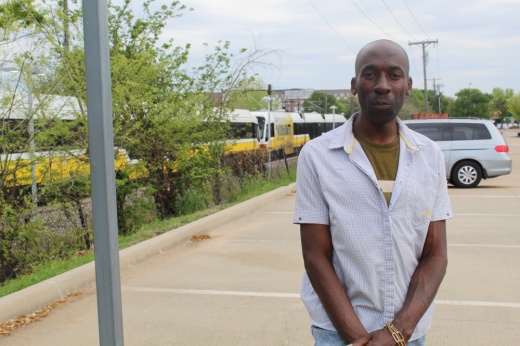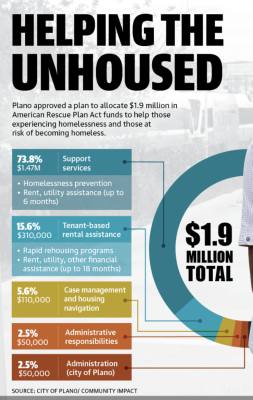Most nights, Hayes will spend $15 on a bed at Dallas-based homeless center Dallas Life if he can, or he will rent a room at a cheap motel in the area if he has a little extra money in his pocket.
"It ain't got to be the best," he said. "But your head is covered."
Hayes has experienced homelessness for extended periods of time since 2009, when his caretaker died from cancer. Even though he said he has had his own apartment at certain times in the last 14 years, Hayes considers himself a "long-term" homeless person.
"[I've had homelessness] breaks from time to time; I have had my own place before," he said. "But I have lived in [homelessness] for such a long time, and I'm still living in it, ... I know how it is to have been blessed with something and finding out the next day that you might lose it.”
Plano officials are actively working to reduce the number of people experiencing homelessness in the city, and nearly $2 million of federal funds is the city’s latest tool to help people like Hayes.
Plano City Council approved a plan for $1.9 million from the Department of Housing and Urban Development’s American Rescue Plan in January. With that money, city staff will partner with nonprofit organizations in the area to help the people who are homeless or at risk of becoming homeless.
“The faster we can get this money out and into the community, the better off our community is going to be,” Council Member Rick Grady said during the meeting.
There are 261 people experiencing homelessness in Plano, according to the city’s 2023 Point-in-Time Count. That’s up by 16.5% from the 2022 count, which reported 224 people experiencing homelessness in Plano.
The Point-in-Time Count’s purpose is to survey and count the number of unsheltered homeless people in the city, but it is not comprehensive, according to Grady, who also works with the Collin County Homeless Coalition.
The count is only a snapshot of one night in the city, and it does not include someone, such as Hayes, who may be sleeping at a shelter in Dallas or Denton. The count also does not include people living out of a hotel/motel or couch surfing.
“We know that number is severely undercut,” Grady said. “We have people that maybe are in transitional housing, but yesterday they were probably homeless.”
Shanette Eaden, Plano housing and community services manager, pointed out Plano ISD has a bus stop at a motel.
“That means we have a lot of residents that are living in hotel/motels,” she said.
Where the money goes
The majority of the federal ARPA funds will go to funding existing programs that help people in danger of becoming homeless.
Around $1.4 million will go to programs to assist Plano residents who make 50% below the area’s median income. Eaden said someone has to have resided in Plano when they became homeless to qualify for programs funded by the city. The program would give around $48,000 for a family of four, according to Eaden.
“HUD will allow us to do 80% [area median income] or below, but the City Council chose to narrow it,” she said. “It’s when you get lower in the incomes that you get people here in Plano just trying to make it, and they need help.”
That financial help could include rent, utility, food or other pressing costs.
“We provide financial assistance in a variety of ways,” said Jay Dunn, Salvation Army of North Texas managing director. “Sometimes that’s episodic, maybe because they’re facing eviction, and sometimes it’s part of a longer-term plan because they’ve lost their job.”
Tenant-based rental assistance, which looks to house people experiencing homelessness, will take up the next largest chunk at $310,000, while the rest of the funds will go toward case management and administrative costs.
Tenant-based rental assistance includes rapid rehousing, a program that has helped 74 families since 2018, according to Eaden. The program gets homeless families or individuals into housing, and provides financial assistance and other services to prevent further episodes of homelessness.
Rapid rehousing takes 30 days, at minimum, according to Eaden.
On the streets
Whether they are waiting for housing, or not in the program, people experiencing homelessness have limited options in Plano.
The Salvation Army opens a weather shelter during extreme cold or extreme heat, and Dunn said the shelter will have 140-plus people on bad nights. There are also a couple of nonprofits that will provide shelter to certain groups, such as City House for children and young adults, and Hope’s Door New Beginning Center for victims of domestic violence.
But for the general homeless population, there is no emergency shelter in all of Collin County.
“The reality is, and it sucks, we don’t have anything,” Eaden said. “When we’re talking about somebody that is literally homeless, and we’re waiting to get them housed, we have nowhere to put them.”
Dunn said the nearest options are emergency shelters in Denton and Dallas.
“Both of which are feasible,” he said. “We can make that happen, but it is a fair amount of ground to cover, so it’s not ideal.”
Eaden said many people experiencing homelessness in Plano are not willing to leave their community, but those who are get the opportunity to return.
“We don’t like to send people away and not bring them back,” Eaden said. “I’m from Plano, like homegrown from Plano, and that’s just not how we do things. That’s not how I want us to do things.”
The path forward
The Salvation Army’s goal is to provide shelter, housing, clinical recovery and other services to everyone who needs them in the communities they serve, according to Dunn.
With no emergency shelter in the city, Dunn knows the organization has “not entirely” reached that goal in Plano. But he added there is a vision to continue enhancing services in Plano.
Dunn said the organization recently received a multimillion-dollar award for scattered-site supportive housing, which will look to place homeless individuals in private apartments throughout the city.
There is no set timeline on the program, but Dunn said it is the next step in the Salvation Army’s “multiyear plan,” which included a food pantry, rent assistance and the warming station.
“We certainly have a vision to do all we can,” Dunn said. “We hope to get to a point where we can start to think about additional facilities, because some of our work does require beds.”
Even with progress left to be made, Dunn thinks the area is heading in the right direction.
“I’ve been in one way or another working in homeless recovery in Texas since ‘98, and we have a clearer path than we’ve ever had,” he said. “I think there’s a growing understanding of the issues, and I think we can get a lot better on these wicked problems.”
Grady said he would “love” to have an emergency homeless shelter in Plano. He added that generosity is the community’s biggest weapon against homelessness.
“When just one person does one thing it can change somebody’s life,” Grady said. “So if 100 people in a city of 285,000 did that to the 100 homeless that are here, there wouldn’t be any homeless.”








